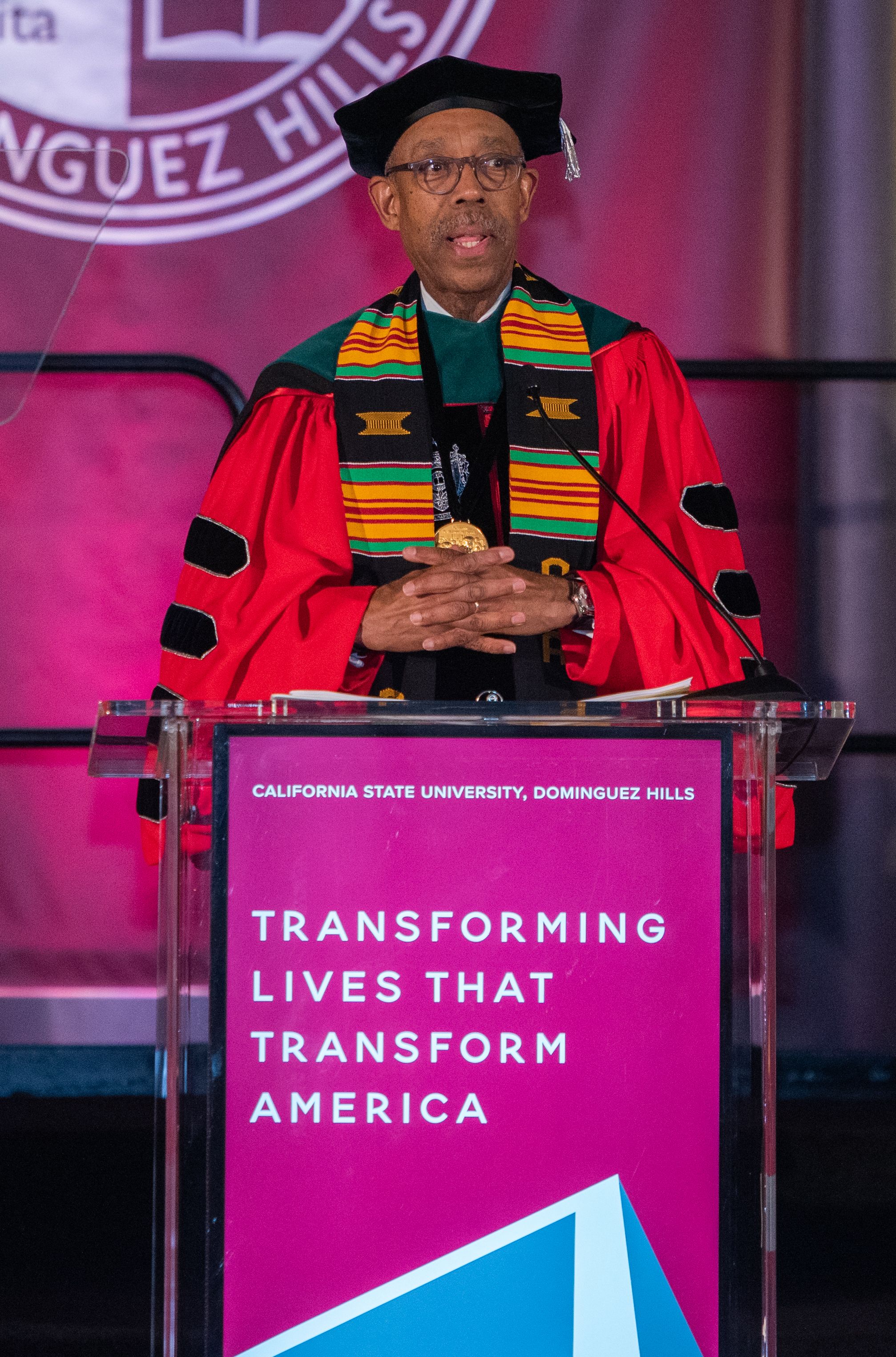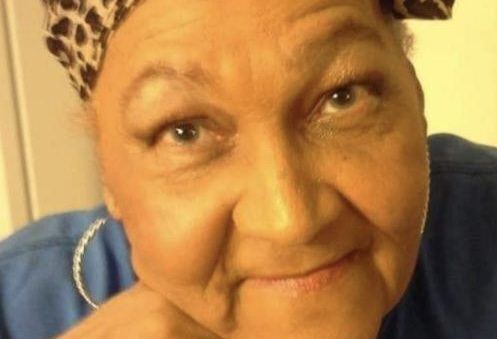Michael Drake, M.D. will become the first African American head of the UC system in its 152-year history.
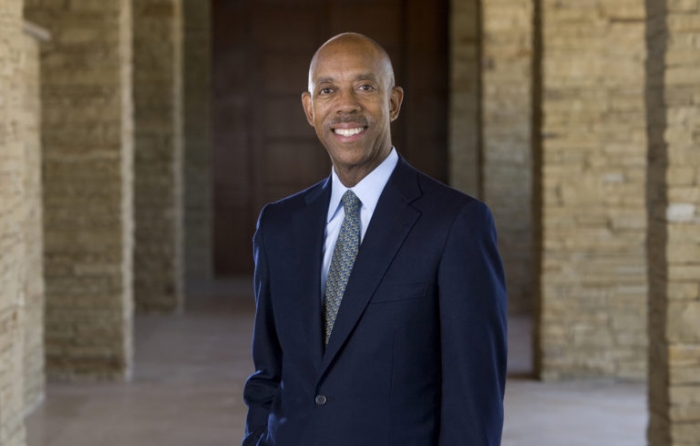
“Education is the passport to the future; for, tomorrow belongs to those who prepare for it today.” These verbal stylings of the late Malcolm X have often served as a mantra for young African American boys, girls, women and men alike, who navigate the challenges of primary, secondary, and higher education in pursuit of their academic dreams and aspirations, as well as careers filled with promise and possibility.
Well, sometimes those dreams do come true, even when one had not planned on a specific outcome. EXTRA, EXTRA: read all about it. Michael Drake, M.D. has just been appointed by the UC Regents to be the next president of the University of California system. His appointment will be effective August 1 of this year. Drake will become the first African American head of the UC system in its 152-year history. That’s a lot of glass to break in that ceiling, but the shattering of that threshold has reverberated throughout the higher education community, and certainly here in California. I want to join the chorus and shout with joy, even as I bear witness to similar Black excellence continuing to shine in California, and other parts of the nation as well.
Dr. Drake, The Man
Michael Drake is an accomplished physician by training, specializing in Ophthalmology. He holds an undergraduate degree from Stanford University, and a medical doctorate from UC San Francisco. He is an accomplished scholar and National Academy of Sciences physician, and seasoned administrator. He is the former vice president for Health Sciences and Health Affairs at the UC Office of the President, former chancellor at UC Irvine, and most recently president at The Ohio State University. But while the degrees and awards speak loudly about what he has done in a stellar career, they do not tell the whole story about who he is.

Dr. Drake is a very principled and transformative leader who is selfless, values driven, personable, politically savvy, visionary, and collaborative. He is constantly in pursuit of excellence, but unlike many institutional leaders, is not moved simply for metrics and ratings sake. Rather, he expects the outcomes produced by the people in the institutions he leads to enhance the quality of people’s lives and experiences. He is a family man who partners with his wife Brenda in everything he does. Her support in turn, is anchored in an intellectually gifted mind, giving and loving heart, and very personable demeanor that is nurturing and caring. Both Brenda and Michael come to this work of facilitating student’s personal and intellectual growth and development with a cultural consciousness that is keenly focused on the legacy they were blessed to inherit, the landscape they have had to navigate to achieve the level of prominence and accomplishments they have, and a broad base of experience that provides the teachable moments that new generations of students, faculty, staff, and senior executives learn from. Indeed, Michael Drake is a renaissance man who is as comfortable in the executive suite as he is a clinical operatory; as composed in a faculty senate meeting as he is delivering a classroom lecture; as sensitive to Black Lives Matter as he is to African American heritage that necessitates his respect for the dignity and humanity of other members of the human family.
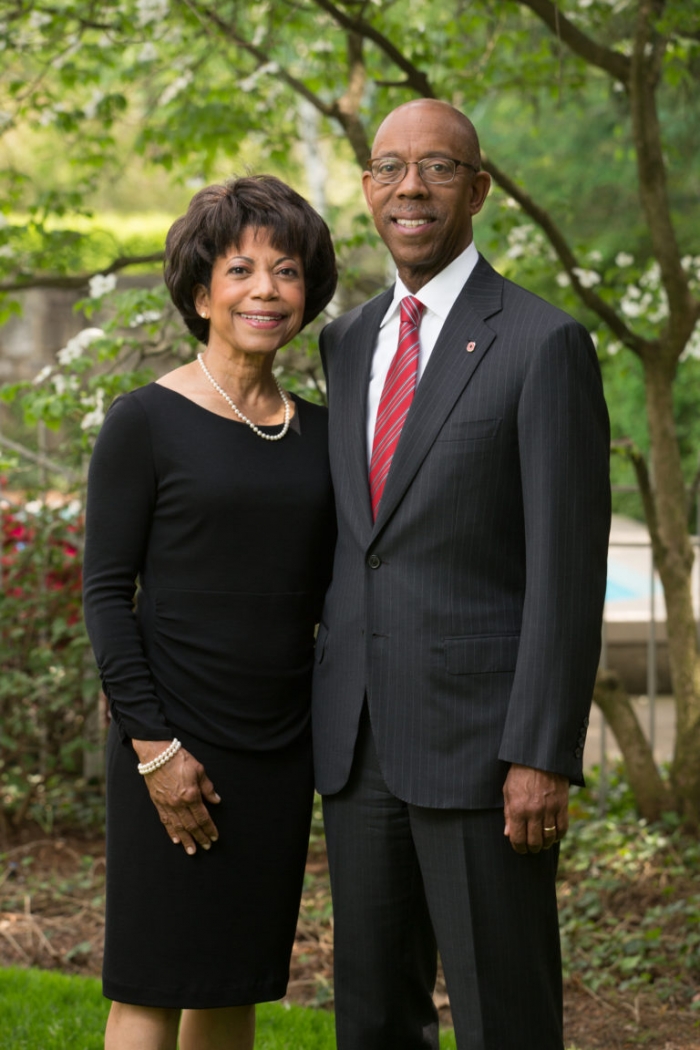
Historic Challenges of Black University Leaders
Owing to the belief that increased educational attainment coupled with substantive experience would lend itself to a greater range of choices and options on the educational career ladder, women and men like Michael Drake have engaged in pursuit of higher education degrees and administrative experiences that should position them for higher level positions. Yet, despite the excellence produced, the degrees attained, and the experiences gained, opportunities at the highest level of president, chancellor, and chief executive of colleges and universities have been an elusive prize for all, but a select few over recent decades. That’s what makes Drake’s appointment to lead the entire UC system so remarkable and compelling.
Over a decade ago, research by “Black Issues In Higher Education” in 2007 (Diverse Magazine – https://diverseeducation.com/article/8499/ ), supported this assertion as there were 105 African American presidents at traditionally White institutions, four of whom were about to retire. As far back as 1996, some ten years earlier, data indicate that the ranks of Black presidents numbered 113. The majority of Black presidents at that time headed two-year institutions, with only thirty-six leading four-year schools. In addition to the chief executives of the 102 historically Black institutions (most of whom are Black), that means approximately 200 institutions out of the roughly 3,800 colleges and universities in the nation — both two-year and four-year — were headed by African Americans.
Unquestionably, data at that time and since then has shown there is plenty of room for improvement in diversifying the ranks of executive leadership. A survey of 1,662 U.S. colleges several years ago found only 6 percent were led by Black presidents, despite the fact that 13.3 percent of the U.S. population is African American. These results mirror findings of a 2012 survey from the American Council on Education (ACE) which was sent to public and private colleges and universities across the U.S., including two-year programs. More recently, in a 2017 study by the American Council on Education, researchers found that individuals who identified as something other than white held just 17 percent of college and university presidencies in 2016, while representing 42 percent of students enrolled in 2015. Among the presidents of color, 36 percent led two-year associate, or two-year, colleges; only 5 percent identified as women of color.
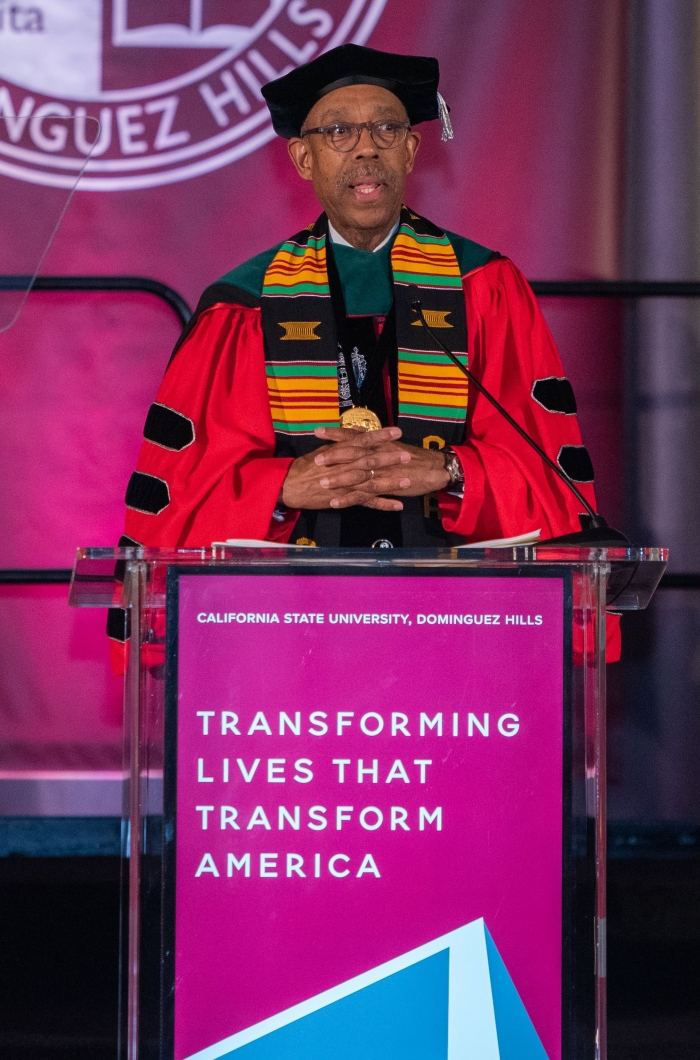
Signs of Progress
That all seems to have changed of late as major research and regional comprehensive institutions have broken through and continued to shatter their own glass ceilings of racial and ethnic diversity progress that extends beyond student demographic percentages on college and university campuses. Evidence of that phenomenon can be seen among the nation’s largest public university system, as the California State University system, comprising 23 campus, now boasts three African Americans, of which I am blessed to be one who leads the Dominguez Hills campus. Dr.’s Soraya Coley at California Polytechnic University Pomona, and Tom Jackson at Humboldt State University are the other African American presidents, and one systemwide executive Dr. Loren Blanchard, who serves as executive vice chancellor for Academic and Student Affairs for the CSU system. However, we are not the first Black presidents by any means in California, though our presence in positions of the highest levels of executive leadership has been sporadic at best.
In the California State University (CSU) system for example, which is the largest system of public higher education in the nation, the color line of Black excellence was broken some forty-one years ago, when Dr. James Rosser was appointed president of California State University Los Angeles in 1979. Within the CSU system, which educates nearly 485,000 students each year across its 23 campuses, there were other African American presidential appointments that followed at CSU Stanislaus (Marvelene Styles Hughes), CSU Northridge (Blenda Wilson), CSU Fullerton (Jewell Plummer Cobb, Milton Gordon), CSU Bakersfield (Horace Mitchell), and CSU Dominguez Hills (Herb Carter, Boyce Bowman, James Lyons, Willie Hagan). In the domain of private colleges, we can point to John Slaughter becoming president of Occidental College in 1988, and Linda Oubr’e being named president of Whittier College in 2018.
Fifteen years ago, it was Dr. Michael Drake who broke the barrier in California’s public research 1 institutions by becoming the first African American to permanently lead a University of California institution when he was appointed Chancellor of the Irvine campus in 2005. He served as Irvine’s chief executive for nine years. Subsequently, he became the first African American appointed to be the President at The Ohio State University, where he served from 2014 until his short-lived retirement in June of this year. In between those years, the UC System chronicled two more milestones, appointing Dr. Gary May as Chancellor of the University of California Davis, and Dr. Michael Brown to serve as systemwide executive vice president and provost under president Janet Napolitano. Well, the UC system has hit the lottery again as the Regents voted this week to name Michael V. Drake, M.D. as its new president.
Across the country, the recent appointment of Darryl Pines to the University of Maryland College Park’s chief post brings to three the number of African American presidents serving the state’s University of Maryland system (Freeman Hrobowski at University of Maryland Baltimore County, and Heidi Anderson at The University of Maryland Eastern Shore (excluding presidents at HBCU’s). In nearby Virginia, the recent appointment of UC Irvine’s Dean of the Samueli School of Engineering Dr. Gregory Washington as President of George Mason University becomes a historic achievement as he in the first African American to hold that post in that university’s history. The naming of Jonathan Holloway to the presidency at Rutgers University New Brunswick becomes a historic first as well, and recently Dr. Lori White (the oldest daughter of famed Black psychologist Dr. Joseph L. White) as the first African American and woman at Depauw University in Indiana follows that trend.
Recent appointments of African American men and women as president, and other senior administrative positions points to an inclination that Boards of Trustees and Regents have begun to initiate a change in their hiring practices. While it is difficult to make precise attribution about why, I suspect that more diverse board compositions, confronting and relaxing unconscious biases, student protests and demonstrations, congruent matches between a candidate’s background and an institution’s need, and public pressure may in part account for the trends higher education is now witnessing. It is also worth noting that these individuals identified above are exceptionally well qualified, and bring to their roles as president an impressive blend of academic, co-curricular, and administrative experience. Whatever the reason for the explosion of appointments, it seems clear that the landscape of higher education is changing, becoming more culturally rich, and decidedly Black.

Looking Beyond Desegregating the Presidency
Beyond the historic implications of many of these appointments the nation is now witnessing, higher education has done itself a great service by further opening-up these doors of opportunity for Black people. Indeed, beyond being the beacons of intellectual enlightenment, scientific discovery, knowledge acquisition, innovation, and co-curricular learning, these colleges and universities provide a platform from which African American chief executives can demonstrate their visionary, intellectual, administrative, fiscal, student centered, athletic, and fundraising leadership. These supremely gifted men and women are more than just a single variable increase of a frequency distribution. They allow for an infusion the culturally rich values that characterize a worldview that is often different than their White counterparts bring to their roles. Expect the presidents/chancellors chronicled above to provide that necessary texture to the policies and practices of the institutions they now lead, and to higher education more broadly. Also, expect Michael Drake’s influence to penetrate throughout the entire 10-campus UC system, as he continues to make his mark on the world of higher education. He is that good; he is that respected; he is that determined, and he is that culturally conscious.
Cautious Reflections
But, being African American in these positions of power and influence, while a celebratory moment for us all, presents challenges of their own, many of which are unique to Black people. The seminal scholar, Asa G. Hilliard III, argued that there was something wrong with an educational system that leaves Black people strangers to themselves, aliens to their culture, oblivious to their condition in America and around the world, and inhuman to their oppressors. And, in the wake of the George Floyd, Breonna Taylor, and Ahmaud Aubrey murders, Black Lives Matter advocacy, and universities looking to reconcile their contemporary image with a new found recognition of a racist and oppressive past, the burden for addressing those issues in higher education will fall squarely on the shoulders of presidential leaders like President Drake and others. Don’t expect him to flinch.
Ironically, while we celebrate these milestones in Black achievement here, many university African American chief executives will be perceived as “too Black” for some in their institutions and communities, or “not being Black enough,” at some moment in our careers for other cohorts of colleagues and students who expectations about what should change and the pace at which that change should occur will be a point of contention. Added to that will also be the usual issues of shared governance, union demands, budget and fiscal issues, questions of police reforms, enrollment challenges, free speech debates, athletics, faculty recruitments and retention, research productivity, development and fundraising, and adaptations to a health crisis and global pandemic that is changing the landscape of how universities function in this virtual reality.
Each president, including Dr. Drake, will also have to confront the internal dissonance of managing their cultural selves in the midst of institutional legacies and academic cultures that are more Eurocentric in orientation, and oftentimes less supportive of different cultural worldviews. Indeed, I have argued in my previous writings that the central identity question that must be asked and answered is: how does one maintain a sense of cultural integrity in a world that does not support or affirm your humanity as a person of African descent? That can sometimes be a delicate dance for many, but less so for people used to navigating the waters of higher education’s executive suite.
The passport to Michael Drake’s future has been stamped with a measure of intellectual and emotional fortitude, parental love and support, and an uncommon sensibility and personal agency to turn a personal dream into reality, while being comfortable to accept unexpected opportunities that came his way. That allowed him to navigate the terrain of undergraduate education, medical school, residency in ophthalmology, a senior executive position in the University of California system office, a chancellorship at UC Irvine, a presidency at Ohio State, and now being named president of the UC System. Indeed, his passport book has certainly seen a full range of university experiences, but this latest stamp may be his crowning achievement. In that way, his journey, while filled with both joy and pain, is a symbol of possibility and potential for so many others who are ready to seize the moment when opportunity presents itself. For now, we welcome him and his spouse and partner, Brenda, home and back to California where opportunities abound and new challenges await. Let’s make sure that he has the support he needs from the community. Afterall, our children’s futures are at stake and he is exactly the right man for the job. Amid the tensions of the moments and the adversities of the day, I suspect that the ancestors and elders are smiling today at Michael Drake’s appointment. We all should be smiling as well.



